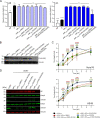Alternative translation contributes to the generation of a cytoplasmic subpopulation of the Junín virus nucleoprotein that inhibits caspase activation and innate immunity
- PMID: 38294249
- PMCID: PMC10878266
- DOI: 10.1128/jvi.01975-23
Alternative translation contributes to the generation of a cytoplasmic subpopulation of the Junín virus nucleoprotein that inhibits caspase activation and innate immunity
Abstract
The highly pathogenic arenavirus, Junín virus (JUNV), expresses three truncated alternative isoforms of its nucleoprotein (NP), i.e., NP53kD, NP47kD, and NP40kD. While both NP47kD and NP40kD have been previously shown to be products of caspase cleavage, here, we show that expression of the third isoform NP53kD is due to alternative in-frame translation from M80. Based on this information, we were able to generate recombinant JUNVs lacking each of these isoforms. Infection with these mutants revealed that, while all three isoforms contribute to the efficient control of caspase activation, NP40kD plays the predominant role. In contrast to full-length NP (i.e., NP65kD), which is localized to inclusion bodies, where viral RNA synthesis takes place, the loss of portions of the N-terminal coiled-coil region in these isoforms leads to a diffuse cytoplasmic distribution and a loss of function in viral RNA synthesis. Nonetheless, NP53kD, NP47kD, and NP40kD all retain robust interferon antagonistic and 3'-5' exonuclease activities. We suggest that the altered localization of these NP isoforms allows them to be more efficiently targeted by activated caspases for cleavage as decoy substrates, and to be better positioned to degrade viral double-stranded (ds)RNA species that accumulate in the cytoplasm during virus infection and/or interact with cytosolic RNA sensors, thereby limiting dsRNA-mediated innate immune responses. Taken together, this work provides insight into the mechanism by which JUNV leverages apoptosis during infection to generate biologically distinct pools of NP and contributes to our understanding of the expression and biological relevance of alternative protein isoforms during virus infection.IMPORTANCEA limited coding capacity means that RNA viruses need strategies to diversify their proteome. The nucleoprotein (NP) of the highly pathogenic arenavirus Junín virus (JUNV) produces three N-terminally truncated isoforms: two (NP47kD and NP40kD) are known to be produced by caspase cleavage, while, here, we show that NP53kD is produced by alternative translation initiation. Recombinant JUNVs lacking individual NP isoforms revealed that all three isoforms contribute to inhibiting caspase activation during infection, but cleavage to generate NP40kD makes the biggest contribution. Importantly, all three isoforms retain their ability to digest double-stranded (ds)RNA and inhibit interferon promoter activation but have a diffuse cytoplasmic distribution. Given the cytoplasmic localization of both aberrant viral dsRNAs, as well as dsRNA sensors and many other cellular components of innate immune activation pathways, we suggest that the generation of NP isoforms not only contributes to evasion of apoptosis but also robust control of the antiviral response.
Keywords: Junín virus; alternative translation; arenavirus; caspase activation; exonuclease activity; interferon antagonism; nucleoprotein.
Conflict of interest statement
The authors declare no conflict of interest.
Figures






Similar articles
-
Lassa Virus, but Not Highly Pathogenic New World Arenaviruses, Restricts Immunostimulatory Double-Stranded RNA Accumulation during Infection.J Virol. 2020 Apr 16;94(9):e02006-19. doi: 10.1128/JVI.02006-19. Print 2020 Apr 16. J Virol. 2020. PMID: 32051278 Free PMC article.
-
A Map of the Arenavirus Nucleoprotein-Host Protein Interactome Reveals that Junín Virus Selectively Impairs the Antiviral Activity of Double-Stranded RNA-Activated Protein Kinase (PKR).J Virol. 2017 Jul 12;91(15):e00763-17. doi: 10.1128/JVI.00763-17. Print 2017 Aug 1. J Virol. 2017. PMID: 28539447 Free PMC article.
-
Highly Pathogenic New World Arenavirus Infection Activates the Pattern Recognition Receptor Protein Kinase R without Attenuating Virus Replication in Human Cells.J Virol. 2017 Sep 27;91(20):e01090-17. doi: 10.1128/JVI.01090-17. Print 2017 Oct 15. J Virol. 2017. PMID: 28794024 Free PMC article.
-
The Virus-Host Interplay in Junín Mammarenavirus Infection.Viruses. 2022 May 24;14(6):1134. doi: 10.3390/v14061134. Viruses. 2022. PMID: 35746604 Free PMC article. Review.
-
Strategies of highly pathogenic RNA viruses to block dsRNA detection by RIG-I-like receptors: hide, mask, hit.Antiviral Res. 2013 Dec;100(3):615-35. doi: 10.1016/j.antiviral.2013.10.002. Epub 2013 Oct 12. Antiviral Res. 2013. PMID: 24129118 Free PMC article. Review.
Cited by
-
Restoration of virulence in the attenuated Candid#1 vaccine virus requires reversion at both positions 168 and 427 in the envelope glycoprotein GPC.J Virol. 2024 Apr 16;98(4):e0011224. doi: 10.1128/jvi.00112-24. Epub 2024 Mar 20. J Virol. 2024. PMID: 38506509 Free PMC article.
References
-
- Buchmeier M, Peters CJ, d.l.T.J . 2007. Arenaviridae: the viruses and their replication, p 1791–1828. In H.P. e, Knipe DM (ed), Fields Virology. Lippincott Williams & Wilkins Philadelphia.
-
- Radoshitzky SR, Bào Y, Buchmeier MJ, Charrel RN, Clawson AN, Clegg CS, DeRisi JL, Emonet S, Gonzalez J-P, Kuhn JH, Lukashevich IS, Peters CJ, Romanowski V, Salvato MS, Stenglein MD, de la Torre JC. 2015. Past, present, and future of arenavirus taxonomy. Arch Virol 160:1851–1874. doi:10.1007/s00705-015-2418-y - DOI - PubMed
Publication types
MeSH terms
Substances
Grants and funding
LinkOut - more resources
Full Text Sources
Miscellaneous

